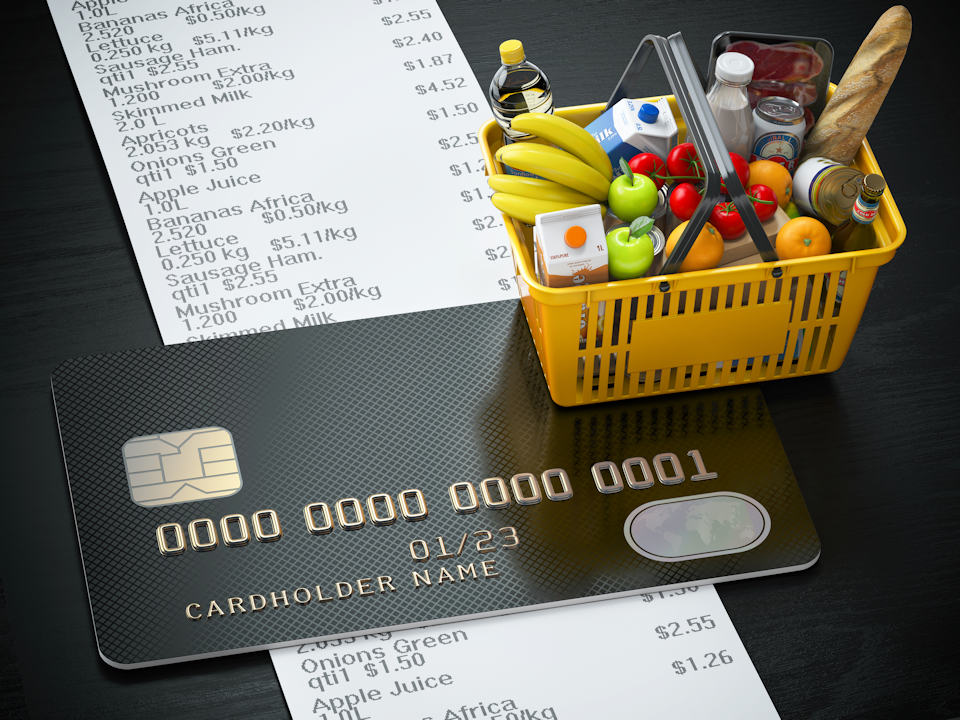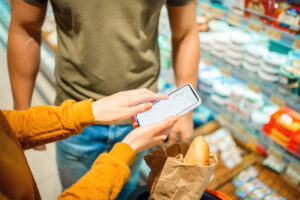Although grocery stores have remained open during the pandemic, at its height many regular in-store shoppers turned to online grocery shopping. Some of shoppers had their online purchases delivered to their homes while others opted to pick-up their orders curbside. During this time, there was much speculation about whether online grocery sales and home delivery services would plateau then decline once shoppers settled into more normal routines. Earlier this year, the downward trend looked all but certain. Grocery sector journalist Russell Redman reported, “Online grocery sales fell again on a sequential basis in May, with the month-to-month decrease nearly double the size of the decline in April, strategic advisory firm Brick Meets Click reported.”[1] He also reported that curbside pick-up was gaining traction with online shoppers while home delivery was plateauing.
The downward trend in online grocery shopping was surprisingly reversed in June. Grocery sector journalist Jeff Wells (@JeffWellsWH) reports online grocery sales in June were up 8.3% year over year.[2] The jump was even higher in July. Wells reports, “Online grocery sales in the U.S. increased 17% in July year over year, to $7.8 billion, as inflation and COVID-19 anxieties continue to drive increases in the channel, according to the latest monthly e-commerce report from Brick Meets Click and Mercatus.” Not only did grocery sales rise in July, so did the number of consumers shopping online. The staff at The Shelby Report explains, “During July, more than 68 million households went online to buy groceries, a 3 percent gain versus last year.”[3]
COVID is Still Having an Impact
While it is understandable that some shoppers are still wary about venturing out too frequently into public spaces because of COVID-19, it may surprise some people that inflation would also cause consumers to shop online for food. Redman explains many of them are bargain hunting. He writes, “Rising food price inflation is influencing where and how consumers shop online for groceries. As escalating prices sap purchasing power, grocery customers are searching for ways to pay no more than necessary when shopping online.” However, Wells notes, “Consumers’ desire to limit their spending amid ongoing inflation has recently challenged the growth of online grocery, which carries extra fees and, in many cases, markups on product prices.” Nevertheless, he notes that concerns about COVID and rising food prices “are driving increases in e-commerce sales during the summer months.”
Evidence that inflation is having an impact on online grocery shopping is reflected in the fact that store loyalty is being tested. The Shelby Report staff notes, “The widening gap in repeat intent is especially concerning because cross-shopping between grocery [stores] and mass [retailers] increased to 30 percent in July, 4 points higher than last year. This means that 3 in 10 customers who placed at least one online order with grocery during the past 30 days also placed an order with a mass retailer. These results should motivate grocery retailers to reassess elements of their value proposition as well as how well they are executing their respective strategies.”
Grocers and CPG Manufacturers Prefer In-store Shoppers
Although grocery stores are grateful for any business, consumers shopping online are generally more expensive to service. Business journalist Sapna Maheshwari (@sapna) explains, “Online orders are costly for grocers, which already have incredibly thin profit margins and now find themselves building infrastructure to perform a task previously done by customers. Many customers expect the service to be cheap and fast, which requires labor.”[4] Much of that labor involves pickers — as Maheshwari points out, a task traditionally performed by customers. Maheshwari writes, “The pandemic prompted millions of Americans to buy their groceries online and pick them up curbside or have them delivered, fueling new demand for so-called pickers. … Pickers, in turn, find themselves doing work that can be physically taxing, mentally stifling and increasingly guided by automation and technology.”[4]
Many pickers are graded on how quickly they pick orders, which means their selectively is often overridden by time constraints. Maheshwari explains, “Grocery stores are designed for browsing, meaning an order that sends a picker to the bakery or in search of flowers can derail their attempts to be efficient.” Design expert Shoshana Burgett (@ColorKarma) notes that consumer packaged goods (CPG) manufacturers, especially brand name manufacturers, are not happy when product decisions are taken out of the hands of consumers. She explains, “The ultimate moment of truth is defined as the moment a consumer picks a product off the shelf to make a purchase. … The physical product, it’s appearance, packaging, display, etc., are all elements to that final moment. They are used to help grab the consumer’s attention at the shelf, communicate the brand, product message, necessary details, and make products easily identifiable for repeat shopping. Using the moment of truth approach, CPG companies assume that the person at the shelf selecting products is the actual consumer.”[5] That’s obvious not true when a picker is involved. As a result, writes Burgett, “Brands now must reevaluate the customer journey, this time focusing on both the consumer and gig employees, who act as both fulfillment officers and brand ambassadors.”
Burgett also observes that online shoppers don’t make impulsive purchases. She explains, “Customers are no longer at the shelf to see promotions; they don’t walk by the end caps, those display areas in-between the isles that brands pay a premium for. We typically go grocery shopping with a list, but who hasn’t come home with a few ‘extra’ items in their cart? This won’t happen with a gig worker.” This means brands need to reconsider how they conduct their trade promotions and how they package their products. Burgett explains, “Brand managers should begin to reevaluate their brand packaging from a gig worker experience. The packaging needs to be easily identifiable, with bolder or more contrast between the same family of products.”
Concluding Thoughts
With pharmaceutical companies furiously working to find universal vaccines for the coronavirus family, things may someday get back to a more normal state. Will online grocery survive in a future without COVID? I believe it will. First, many baby boomers have discovered the convenience of online shopping and, as their children take away their keys, the value of delivery services. During the pandemic, they have educated themselves about online shopping and their favorite grocery store has provided them with a convenient app through which they can place their order. Second, e-commerce journalist Jackie Barba reports, “New research from design agency ChaseDesign explores how online shopping for groceries is stabilizing.”[6] The research concludes online shopping will probably stabilize somewhat lower than it is currently, but will remain a viable option for buying food. Grocery sector journalist Lynn Petrak adds that research from Chicory concludes, “[Online grocery shopping] habits are becoming more entrenched.”[7]
According to Barba, “The reason cited most often by consumers for not wanting to shop online for groceries is that they prefer to shop in a physical store. ‘This is driven by a lack of trust in having retailers pick and deliver exactly what the customer wants,’ said Joe Lampertius, president of ChaseDesign. ‘Our survey shows 33% of shoppers have issues with the quality of products selected and a slightly lower percentage are worried about availability through the digital platform.'” That may be good news for both grocers and CPG manufacturers, who would love to see more shoppers browsing the aisles.
Footnotes
[1] Russell Redman, “U.S. e-grocery sales trend down again in May,” Supermarket News, 13 June 2022.
[2] Jeff Wells, “Online grocery sales increased 17% in July,” Grocery Dive, 9 August 2022.
[3] Staff, “U.S. Online Grocery Sales Climb To $7.8 Billion From Year Ago,” The Shelby Report, 9 August 2022.
[4] Sapna Maheshwari, “It’s Hard Work to Make Ordering Groceries Online So Easy,” The New York Times, 4 June 2022.
[5] Shoshana Burgett, “CPG Brands Have Lost Control of the Final Moment of Truth,” Color Karma, May 2022.
[6] Jackie Barba, “Has Online Grocery Shopping Hit a Plateau?” Path to Purchase Institute, 28 July 2022.
[7] Lynn Petrak, “Consumers Turn to Online Content to Browse, Buy Groceries,” Progressive Grocer, 12 April 2022.





